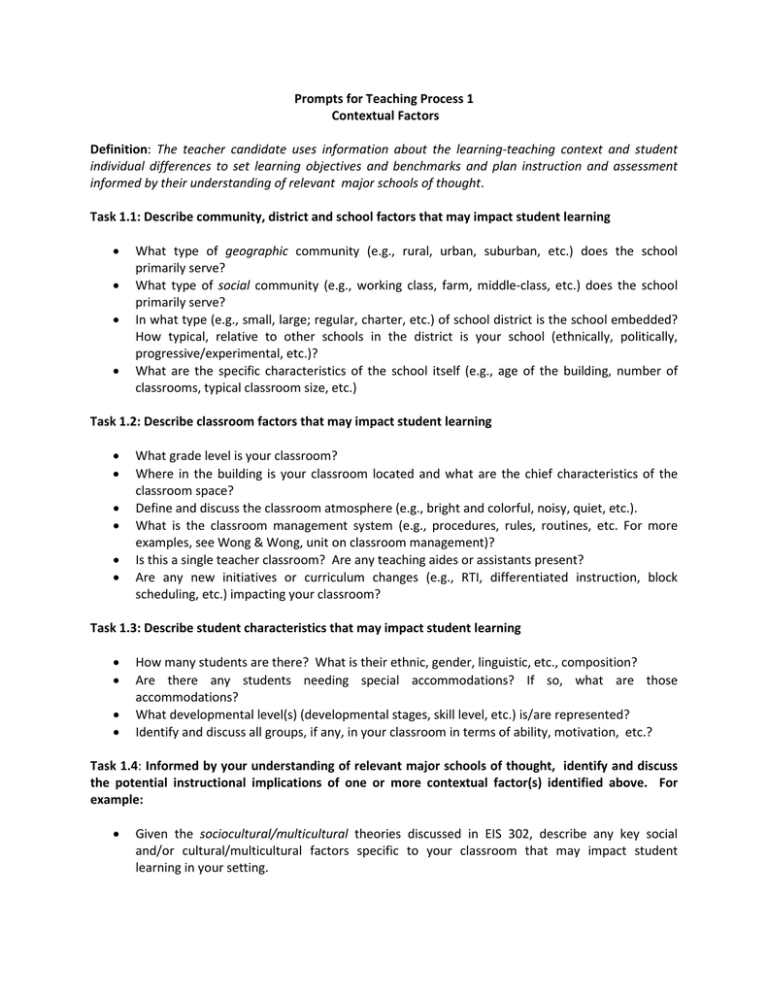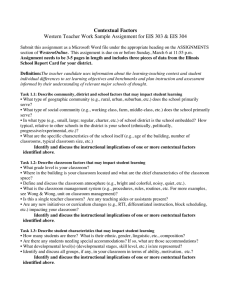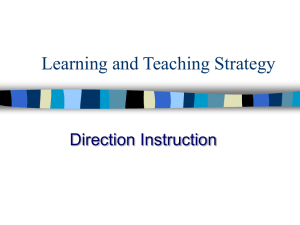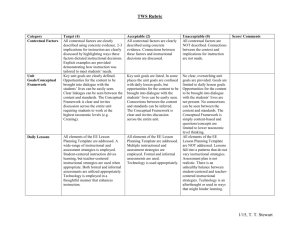Prompts for Teaching Process 1 Definition Contextual Factors
advertisement

Prompts for Teaching Process 1 Contextual Factors Definition: The teacher candidate uses information about the learning-teaching context and student individual differences to set learning objectives and benchmarks and plan instruction and assessment informed by their understanding of relevant major schools of thought. Task 1.1: Describe community, district and school factors that may impact student learning • • • • What type of geographic community (e.g., rural, urban, suburban, etc.) does the school primarily serve? What type of social community (e.g., working class, farm, middle-class, etc.) does the school primarily serve? In what type (e.g., small, large; regular, charter, etc.) of school district is the school embedded? How typical, relative to other schools in the district is your school (ethnically, politically, progressive/experimental, etc.)? What are the specific characteristics of the school itself (e.g., age of the building, number of classrooms, typical classroom size, etc.) Task 1.2: Describe classroom factors that may impact student learning • • • • • • What grade level is your classroom? Where in the building is your classroom located and what are the chief characteristics of the classroom space? Define and discuss the classroom atmosphere (e.g., bright and colorful, noisy, quiet, etc.). What is the classroom management system (e.g., procedures, rules, routines, etc. For more examples, see Wong & Wong, unit on classroom management)? Is this a single teacher classroom? Are any teaching aides or assistants present? Are any new initiatives or curriculum changes (e.g., RTI, differentiated instruction, block scheduling, etc.) impacting your classroom? Task 1.3: Describe student characteristics that may impact student learning • • • • How many students are there? What is their ethnic, gender, linguistic, etc., composition? Are there any students needing special accommodations? If so, what are those accommodations? What developmental level(s) (developmental stages, skill level, etc.) is/are represented? Identify and discuss all groups, if any, in your classroom in terms of ability, motivation, etc.? Task 1.4: Informed by your understanding of relevant major schools of thought, identify and discuss the potential instructional implications of one or more contextual factor(s) identified above. For example: • Given the sociocultural/multicultural theories discussed in EIS 302, describe any key social and/or cultural/multicultural factors specific to your classroom that may impact student learning in your setting. • • Given the psychological theories (e.g., learning, motivation, development, etc.) discussed in EIS 201 and EIS 301, what student characteristics specific to your classroom do you need to keep in mind as you select benchmarks, objectives, and begin the process of designing your instructional strategy? Given your knowledge of legal and ethical issues as discussed in EIS 401, what student characteristics specific to your classroom do you need to keep in mind as you select benchmarks, objectives, and begin the process of designing your instructional strategy? TEACHING PROCESS 1 RUBRIC Contextual Factors Indicator Description of community, district and school factors that may impact student learning Task 1.1 Description of classroom factors that may impact student learning Task 1.2 Description of student characteristics that may impact student learning Task 1.3 Identification and discussion of the potential instructional implications of one or more contextual factor(s) as informed by your understanding of relevant major schools of thought Task 1.4 8/07/09 - FINAL Unacceptable (1) Acceptable (2) Description of community, district and school factors that may impact student learning is severely limited, irrelevant, inaccurate, and/or missing. Description of classroom factors that may impact student is severely limited, irrelevant, inaccurate, and/or missing. Basic, accurate and perceptive description of community, district and school factors that may impact student learning is provided. Detailed, accurate and perceptive description of community, district and school factors that may impact student learning is provided. Target (3) Basic, accurate and perceptive description of classroom factors that may impact student learning is provided. Detailed, accurate and perceptive description of classroom factors that may impact student learning is provided. Description of student characteristics that may impact student learning is severely limited, irrelevant, inaccurate, and/or missing. Identification and discussion of the potential instructional implications of one or more contextual factor(s) informed by understanding of the relevant major schools of thought severely is limited, irrelevant, inaccurate, and/or missing. Basic, accurate and perceptive description of student characteristics that may impact student learning is provided. Basic and accurate identification and thoughtful discussion of the potential instructional implications of one or more contextual factor(s) informed by understanding of the relevant major schools of thought is provided. Detailed, accurate and perceptive description of student characteristics that may impact student learning is provided. Detailed and accurate identification and thoughtful discussion of the potential instructional implications of one or more contextual factor(s) informed by understanding of the relevant major schools of thought is provided. Score



